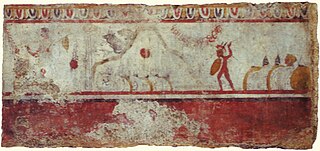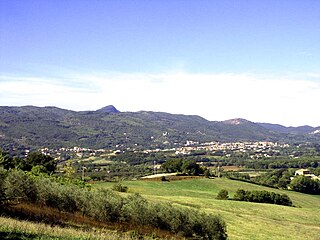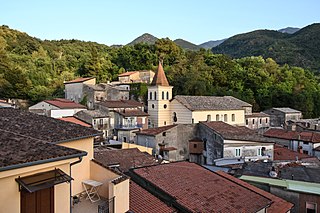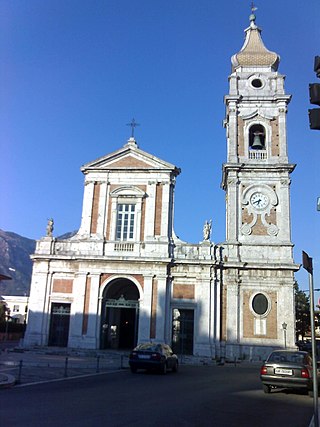
Avellino is a town and comune, capital of the province of Avellino in the Campania region of southern Italy. It is situated in a plain surrounded by mountains 47 kilometres (29 mi) east of Naples and is an important hub on the road from Salerno to Benevento.

The Battle of Caudine Forks, 321 BC, was a decisive event of the Second Samnite War. Its designation as a battle is a mere historical formality: there was no fighting and there were no casualties. The Romans were trapped in an enclosed valley by the Samnites before they knew what was happening and nothing remained but to negotiate an unfavorable surrender. The action was entirely political, with the magistrates on both sides trying to obtain the best terms for their side without disrespecting common beliefs concerning the rules of war and the conduct of peace. In the end the Samnites decided it would be better for future relations to let the Romans go, while the Romans were impeded in the prosecution of their campaign against the Samnites by considerations of religion and honor.

The province of Avellino is a province in the Campania region of Italy. Its capital is the city of Avellino. The area is characterized by numerous small towns and villages scattered across the province; only two towns have a population over 20,000.

The province of Caserta is a province in the Campania region of Italy. Its capital is the city of Caserta, situated about 36 kilometres (22 mi) by road north of Naples. The province has an area of 2,651.35 square kilometres (1,023.69 sq mi), and had a total population of 924,414 in 2016. The Palace of Caserta is located near to the city, a former royal residence which was constructed for the Bourbon kings of Naples. It was the largest palace and one of the largest buildings erected in Europe during the 18th century. In 1997, the palace was designated a UNESCO World Heritage Site.

The province of Campobasso is a province in the Molise region of Italy. Its capital is the city of Campobasso. It covers an area of c. 2,941 square kilometres (1,136 sq mi) and has a total population of 223,871 (2017). There are 84 comuni in the province.
Terra di Lavoro is the name of a historical region of Southern Italy. It corresponds roughly to the modern southern Lazio and northern Campania and upper north west and west border area of Molise regions of Italy.

Mercogliano is an Italian town and comune in the province of Avellino, Campania, southern Italy.

Rocca San Felice is a town and comune in the province of Avellino, Campania, southern Italy.

San Martino Valle Caudina is a town and comune in the province of Avellino, Campania, Italy.

Montesarchio is a comune in the Province of Benevento, Campania, Southern Italy. It is located 18 kilometres southwest of Benevento in the Valle Caudina at the foot of Monte Taburno. The commune was granted the official status of city (città) by a presidential decree of 31 July 1977. In 2020, it had a population of 13,226. It is a member of the I Borghi più belli d'Italia association.

Airola is a comune (municipality) in the Province of Benevento in the Italian region Campania, located about 35 km northeast of Naples and about 20 km southwest of Benevento in the Valle Caudina, facing the Monte Taburno. Nearby is the confluence of the Tesa and Faenza streams into the Isclero River. Airola's territory is also crossed by the Acquedotto Carolino, carrying waters to the Caserta Palace.

Arpaia is a town, comune (municipality) and former episcopal see in the Province of Benevento in the southern Italian region Campania, located about 35 km northeast of Naples and about 25 km southwest of Benevento.
Dugenta is a comune (municipality) in the Province of Benevento in the Italian region Campania, located about 35 kilometres (22 mi) northeast of Naples and about 30 kilometres (19 mi) west of Benevento.

Morcone is a comune (municipality) in the Province of Benevento in the Italian region Campania, located about 70 km northeast of Naples and about 25 km northwest of Benevento. The villages (Contrade) of Morcone include: Canepino, Cuffiano, Coste, Torre, Fuschi, Piana.
Pannarano is a comune (municipality) in the Province of Benevento in the Italian region Campania, located about 45 kilometres (28 mi) northeast of Naples and about 15 kilometres (9.3 mi) southwest of Benevento. As of 1 January 2020, it had a population of 2,077 and an area of 11.73 square kilometres (4.53 sq mi).

San Salvatore Telesino is a comune (municipality) in the Province of Benevento in the Italian region Campania, located about 50 kilometres (31 mi) northeast of Naples and about 25 kilometres (16 mi) northwest of Benevento.

Sant'Arcangelo Trimonte is a comune (municipality) in the Province of Benevento in the Italian region Campania, located about 70 km northeast of Naples and about 13 km east of Benevento.

Irpinia is a geographical and cultural region of Southern Italy. It was the inland territory of the ancient Hirpini tribe, and its extent matches approximately today's province of Avellino.
Saticula was a Caudini city near the frontier of Campania in southern Italy. In 343 BC, during the First Samnite War, the Roman consul Cornelius attacked it during the campaign against the Samnites in the Battle of Saticula.

Taburno Camposauro is a massif located in the Apennines, to the west of Benevento, in the Campania region of Southern Italy. Its highest peak is the Taburno, at 1,393 m. It is composed of two groups of calcareous mountains separated by a plain. The fauna is affected by human activities, but the birdlife is very diverse. Several historical structures, mainly religious, are located on the massif. A DOC wine is produced in the area.

















